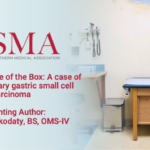Abstract | November 6, 2020
Thinking Outside of the Box: A case of extra-pulmonary gastric small cell carcinoma
Learning Objectives
- Upon completion of this lecture, learners should be better prepared to recognize atypical pathologic diagnoses such as gastric small cell carcinoma to include in their workup of gastric cancer. The purpose of this case study is to bring more awareness to the existence of this rare subtype of small cell carcinoma in order to optimize disease management. Since gastric ESCC is notable for having a greater incidence in Japanese male patients, literature is limited regarding non-Asian populations. Meta- analysis of worldwide gastric small cell carcinomas may be an avenue to improve early diagnosis when a cure may be possible, examine disease pathogenesis, and enhance management.
Introduction: Small cell carcinoma is a neuroendocrine tumor that most commonly arises in the lung but has also been found to originate in a wide variety of extrapulmonary sites. Extrapulmonary small cell carcinomas (ESCCs) are extremely rare; approximately 1000 cases are reported annually in the United States, comprising 0.1-0.4% of all cancers. Gastric ESCC, more commonly seen in Japanese male patients in their seventh decade of life, comprises 8.3–14.5% of ESCC. Our case of a very rare condition is to highlight the importance of including small cell carcinoma in the workup of a gastric malignancy as it has the tendency to present similarly to other, more common, gastric malignancies, but with a very aggressive nature and overall poor prognosis. Less than 15 percent of patients survive up to five years. The hope is to bring more awareness to the existence of this rare subtype of small cell carcinoma in order to diagnose patients earlier in the disease and optimize disease management.
Case Presentation: We present a case of a 72-year old Hispanic male who presented to the emergency department complaining of epigastric abdominal pain and dyspepsia that started 2 days prior. He denied any diarrhea, nausea, vomiting, fever, chills, or blood in stool. Computed tomography scan of abdomen revealed a lobulated soft tissue mass in the proximal\ stomach measuring at least 8.9 x 7.4 cm. Findings were concerning for malignancy and patient was admitted for further evaluation. Differential diagnostic considerations at this time included lymphoproliferative disorder, gastric adenocarcinoma, or metastasis. Esophagogastroduodenoscopy with endoscopic ultrasound revealed a mass that invaded the gastro- esophageal junction. Surgical-Oncology was consulted and recommended laparoscopy and port placement to obtain histological diagnosis and staging due to the very suspicious presence of adenocarcinoma. Initial gastric mass biopsy revealed fibrotic tissue with a focus of lymphocytes. Due to inconclusive pathology, an open biopsy of the perigastric mass was scheduled.
Final Diagnosis: Final pathology report revealed high grade neuroendocrine carcinoma of gastric origin (small cell carcinoma). When the patient had returned 2 months later for evaluation of anemia, CT abdomen revealed right hepatic lobe lesions which were not visualized on the initial scan, reflecting the rapid progression of small cell carcinoma.
Management: Due to tumor progression, post-op complications, and morbidity and mortality rate, patient was not considered a candidate for surgery and was recommended to undergo chemotherapy treatment.

